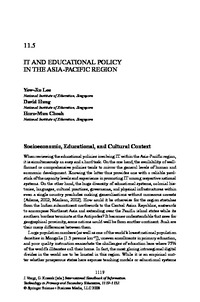IT and Educational Policy in the Asia-Pacific RegionYew-Jin Lee, David Hung, Horn-Mun Cheah
Zu finden in: International Handbook of Information Technology in Primary and Secondary Education (Seite 1119 bis 1132), 2009
|
 |
 Diese Seite wurde seit 12 Jahren inhaltlich nicht mehr aktualisiert.
Unter Umständen ist sie nicht mehr aktuell.
Diese Seite wurde seit 12 Jahren inhaltlich nicht mehr aktualisiert.
Unter Umständen ist sie nicht mehr aktuell.
 Zusammenfassungen
Zusammenfassungen
 The Asian-Pacific region includes not only a large area but many contrasts in the countries involved. Countries that can be classified as advanced in their IT policies (Australia, Chinese Taipei, Hong Kong China, Japan, New Zealand, Republic of Korea, Singapore) differ from those with evolving policies (India, People´s Republic of China, Malaysia, Philippines, Sri Lanka, Thailand) and both differ widely from the less-developed countries in the region such as the Pacific Island states. Key issues relate to infrastructure provision and the need for native-language instructional materials. Also, outside of the Republic of Korea and Australia there are few comprehensive schemes for monitoring or evaluating educational IT policy. Public-private partnerships including those with regional and international aid agencies have an important role in implementing IT in education in the region. IT policy issues in education in the region are illustrated by brief country studies from Sri Lanka and Singapore.
The Asian-Pacific region includes not only a large area but many contrasts in the countries involved. Countries that can be classified as advanced in their IT policies (Australia, Chinese Taipei, Hong Kong China, Japan, New Zealand, Republic of Korea, Singapore) differ from those with evolving policies (India, People´s Republic of China, Malaysia, Philippines, Sri Lanka, Thailand) and both differ widely from the less-developed countries in the region such as the Pacific Island states. Key issues relate to infrastructure provision and the need for native-language instructional materials. Also, outside of the Republic of Korea and Australia there are few comprehensive schemes for monitoring or evaluating educational IT policy. Public-private partnerships including those with regional and international aid agencies have an important role in implementing IT in education in the region. IT policy issues in education in the region are illustrated by brief country studies from Sri Lanka and Singapore. Dieses Kapitel erwähnt ...
Dieses Kapitel erwähnt ...
 Anderswo finden
Anderswo finden
 Volltext dieses Dokuments
Volltext dieses Dokuments
 |  IT and Educational Policy in the Asia-Pacific Region: Artikel als Volltext bei Springerlink ( IT and Educational Policy in the Asia-Pacific Region: Artikel als Volltext bei Springerlink ( : :  , 111 kByte; , 111 kByte;  : :  2020-11-28) 2020-11-28) |
 Anderswo suchen
Anderswo suchen 
 Beat und dieses Kapitel
Beat und dieses Kapitel
Beat hat Dieses Kapitel während seiner Zeit am Institut für Medien und Schule (IMS) ins Biblionetz aufgenommen. Er hat Dieses Kapitel einmalig erfasst und bisher nicht mehr bearbeitet. Beat besitzt kein physisches, aber ein digitales Exemplar. Eine digitale Version ist auf dem Internet verfügbar (s.o.). Aufgrund der wenigen Einträge im Biblionetz scheint er es nicht wirklich gelesen zu haben. Es gibt bisher auch nur wenige Objekte im Biblionetz, die dieses Werk zitieren.











 Biblionetz-History
Biblionetz-History